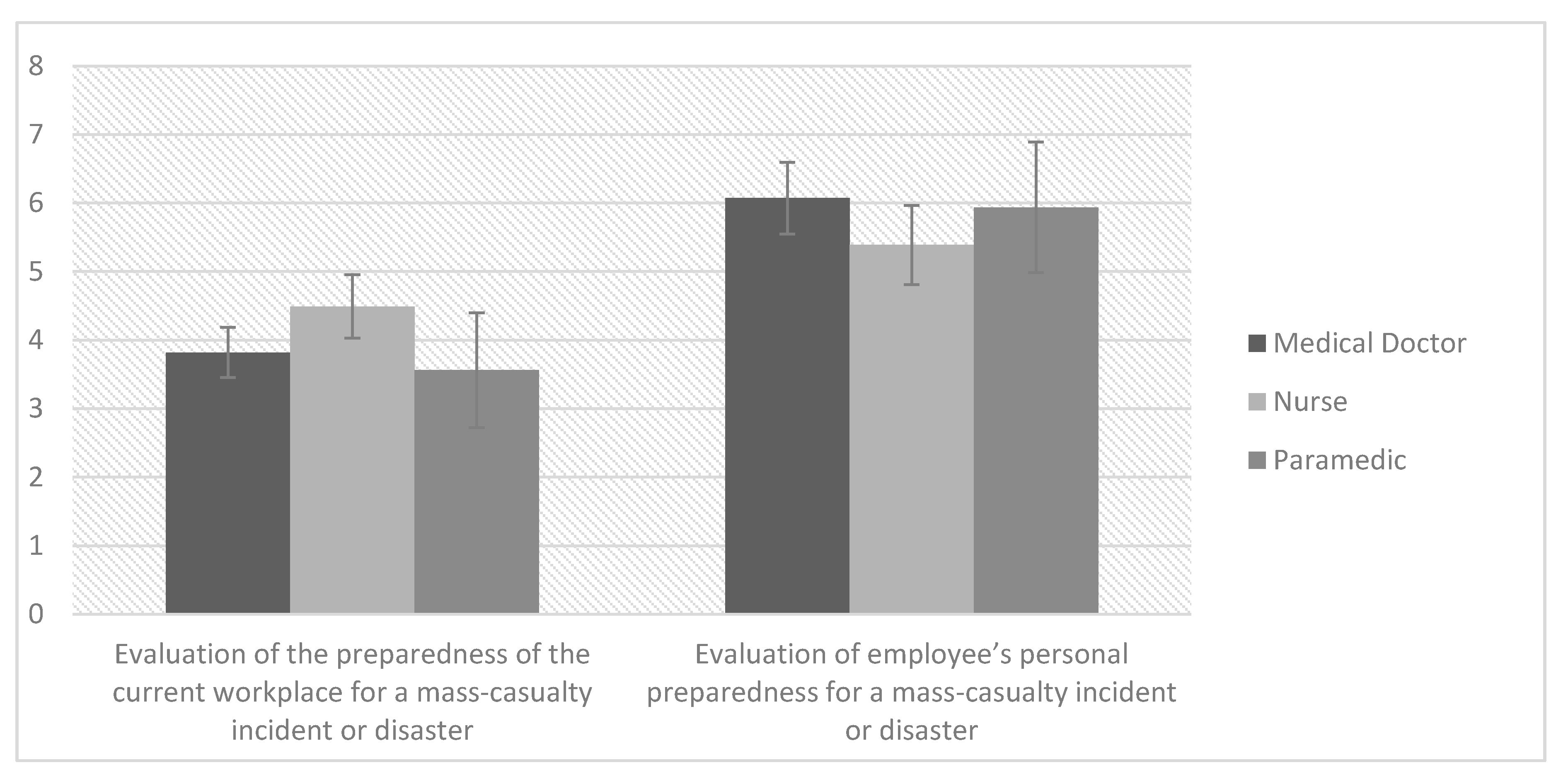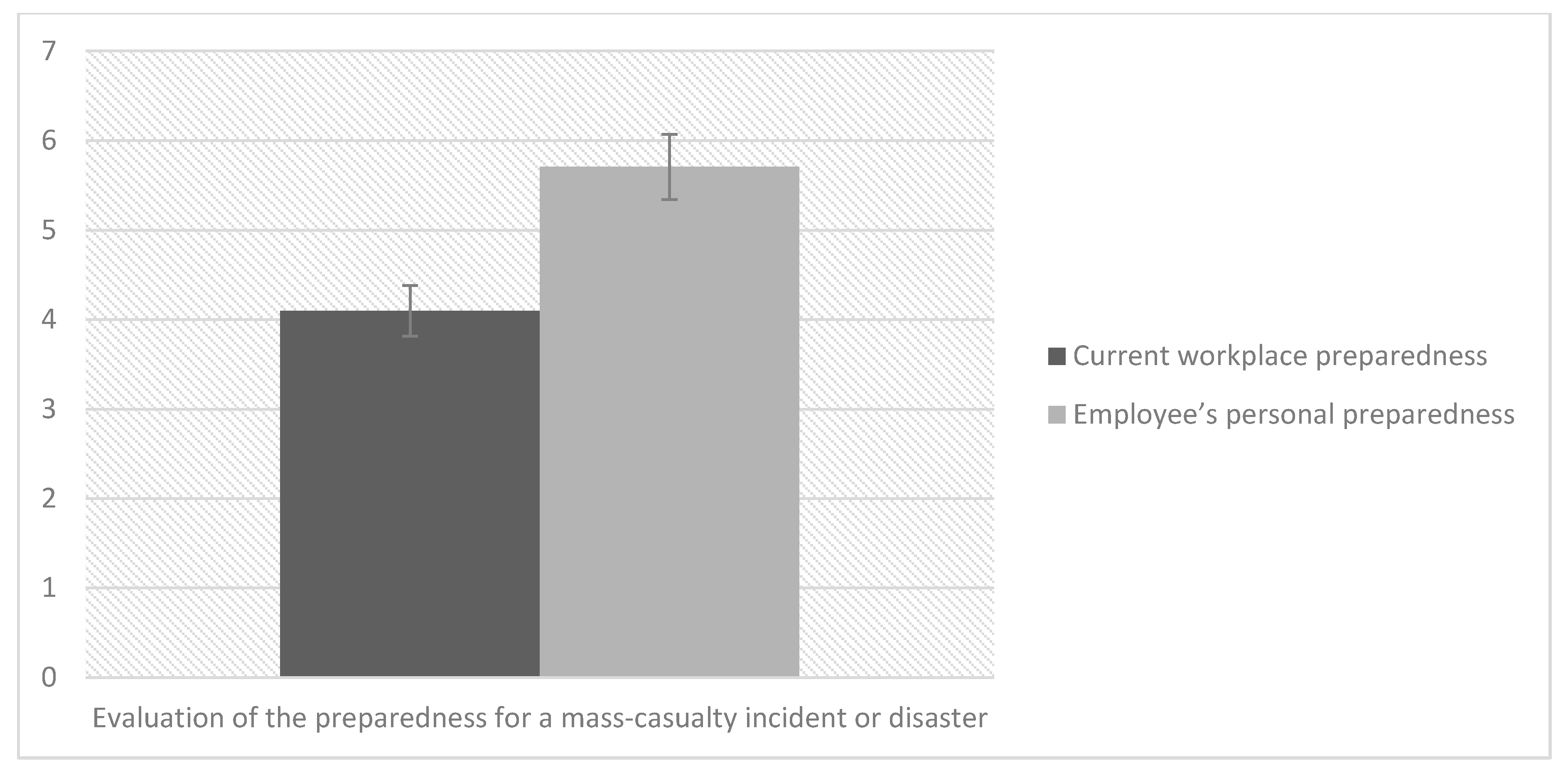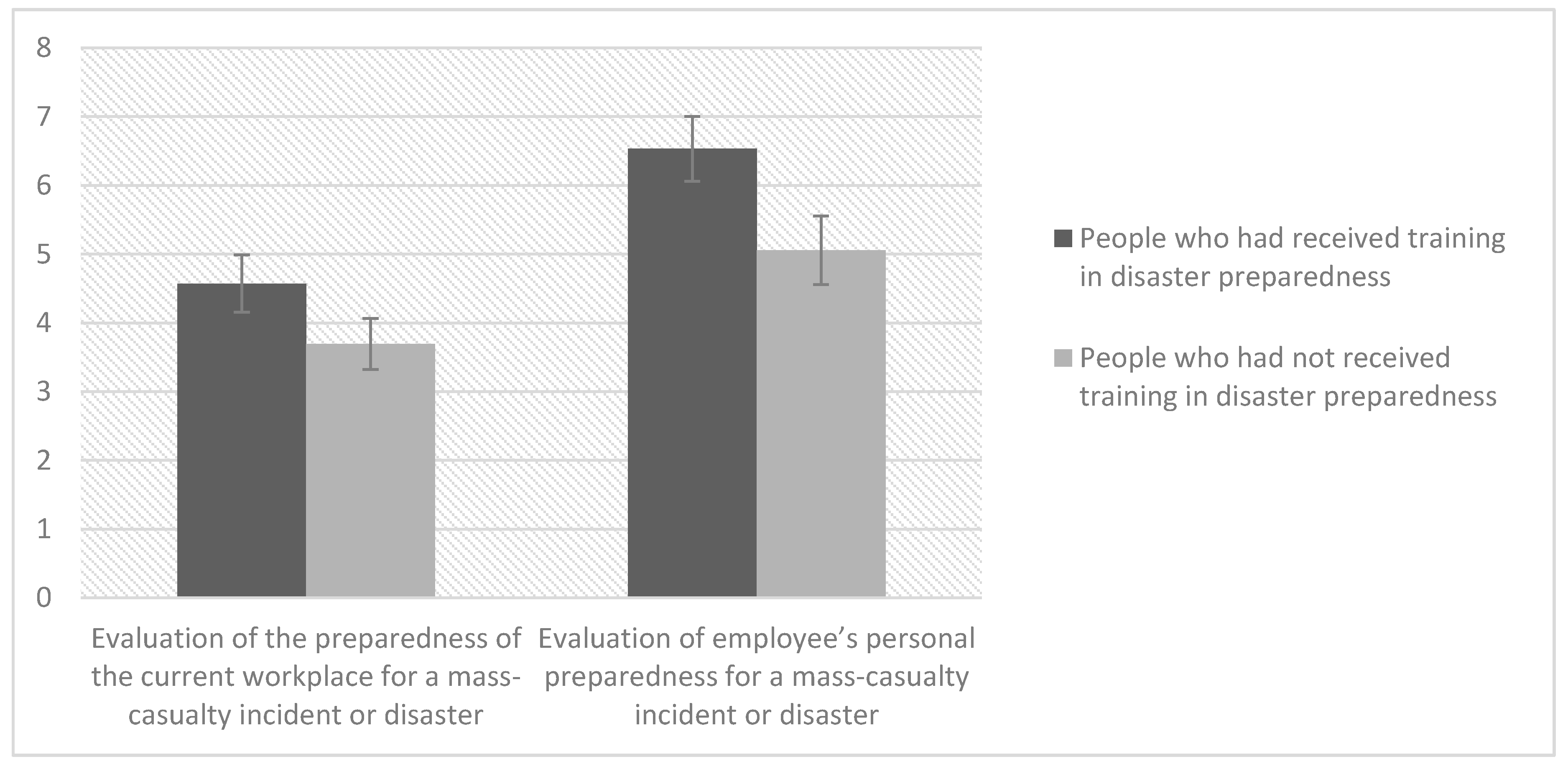Disaster Preparedness and Professional Competence Among Healthcare Providers: Pilot Study Results
Abstract
:1. Introduction
2. Aim
3. Materials and Methods
3.1. Test Site
3.2. Population Studied
3.3. Study Design
3.4. Type of Study
3.5. Data Analysis
3.6. Ethical Considerations
4. Results
4.1. Frequency Analysis
4.2. Relationship between Sociodemographic Variables and Evaluation of Preparedness for Mass-Casualty Incidents and Disasters
4.3. Differences between the Evaluation of Preparedness for a Mass-Casualty Incident or Disaster in the Current Place of Work and the Evaluation of One’s Own Preparedness
4.4. Differences in the Evaluation of Preparedness for a Mass-Casualty Incident or Disaster Depending on Previous Participation in a Mass-Casualty Incident or Disaster as a Healthcare Professional
4.5. Differences in the Evaluation of Preparedness for a Mass-Casualty Incident or Disaster Depending on the Organisation of Drills by the Institution and Whether They Were Attended by the Respondents
5. Discussion
6. Limitations
7. Conclusions
Author Contributions
Funding
Conflicts of Interest
References
- Djalali, A.; Carenzo, L.; Ragazzoni, L.; Azzaretto, M.; Petrino, R.; Della Corte, F.; Ingrassia, P.L. Does hospital disaster preparedness predict response performance during a full-scale exercise? A pilot study. Prehospital Disaster Med. 2014, 29, 441–447. [Google Scholar] [CrossRef] [PubMed]
- Olivieri, C.; Ingrassia, P.L.; Della Corte, F.; Carenzo, L.; Sapori, J.M.; Gabilly, L.; Segond, F.; Grieger, F.; Arnod-Prin, P.; Larrucea, X.; et al. Hospital preparedness and response in CBRN emergencies: TIER assessment tool. Eur. J. Emerg. Med. 2017, 24, 366–370. [Google Scholar] [CrossRef] [PubMed]
- Djalali, A.; Castren, M.; Khankeh, H.; Gryth, D.; Radestad, M.; Öhlen, G.; Kurland, L. Hospital disaster preparedness as measured by functional capacity: A comparison between Iran and Sweden. Prehospital Disaster Med. 2013, 28, 454–461. [Google Scholar] [CrossRef] [PubMed]
- Adini, B.; Laor, D.; Hornik-Lurie, T.; Schwartz, D.; Aharonson-Daniel, L. Improving hospital mass casualty preparedness through ongoing readiness evaluation. Am. J. Med. Qual. 2012, 27, 426–433. [Google Scholar] [CrossRef]
- Cagliuso, N. Stakeholders’ experiences with US hospital emergency preparedness: Part 1. J. Bus. Contin. Emerg. Plan. 2014, 8, 156–168. [Google Scholar]
- Gillett, B.; Silverberg, M.; Roblin, P.; Adelaine, J.; Valesky, W.; Arquilla, B. Computer-facilitated assessment of disaster preparedness for remote hospitals in a long-distance, virtual tabletop drill model. Prehospital Disaster Med. 2011, 26, 230–233. [Google Scholar] [CrossRef]
- Higgins, W.; Wainright III, C.; Lu, N.; Carrico, R. Assessing hospital preparedness using an instrument based on the Mass Casualty Disaster Plan Checklist: Results of a statewide survey. Am. J. Infect. Control 2004, 32, 327–332. [Google Scholar] [CrossRef]
- Mortelmans, L.J.; Gaakeer, M.I.; Dieltiens, G.; Anseeuw, K.; Sabbe, M.B. Are Dutch hospitals prepared for chemical, biological, or radionuclear incidents? A survey study. Prehospital Disaster Med. 2017, 32, 483–491. [Google Scholar] [CrossRef]
- Nekoie-Moghadam, M.; Kurland, L.; Moosazadeh, M.; Ingrassia, P.L.; Della Corte, F.; Djalali, A. Tools and checklists used for the evaluation of hospital disaster preparedness: A systematic review. Disaster Med. Public Health Prep. 2016, 10, 781–788. [Google Scholar] [CrossRef]
- Alruwaili, A.; Islam, S.; Usher, K. Disaster Preparedness in Hospitals in the Middle East: An Integrative Literature Review. Disaster Med. Public Health Prep. 2019, 13, 806–816. [Google Scholar] [CrossRef]
- Lazar, E.J.; Cagliuso, N.V.; Gebbie, K.M. Are we ready and how do we know? The urgent need for performance metrics in hospital emergency management. Disaster Med. Public Health Prep. 2009, 3, 57–60. [Google Scholar] [CrossRef] [PubMed]
- Ogedegbe, C.; Nyirenda, T.; DelMoro, G.; Yamin, E.; Feldman, J. Health care workers and disaster preparedness: Barriers to and facilitators of willingness to respond. Int. J. Emerg. Med. 2012, 5, 29. [Google Scholar] [CrossRef] [PubMed] [Green Version]
- Goniewicz, K.; Misztal-Okońska, P.; Pawłowski, W.; Burkle, F.M.; Czerski, R.; Hertelendy, A.J.; Goniewicz, M. Evacuation from Healthcare Facilities in Poland: Legal Preparedness and Preparation. International J. Environ. Res. Public Health 2020, 17, 1779. [Google Scholar] [CrossRef] [PubMed] [Green Version]
- Beerens, R.J.J.; Tehler, H. Scoping the field of disaster exercise evaluation—A literature overview and analysis. Int. J. Disaster Risk Reduct. 2016, 19, 413–446. [Google Scholar] [CrossRef]
- Hodge, A.J.; Miller, E.L.; Skaggs, M.K.D. Nursing self-perceptions of emergency preparedness at a rural hospital. J. Emerg. Nurs. 2017, 43, 10–14. [Google Scholar] [CrossRef]
- Kollek, D.; Cwinn, A.A. Hospital emergency readiness overview study. Prehospital Disaster Med. 2011, 26, 159–165. [Google Scholar] [CrossRef]
- Cocco, C.; Thomas-Boaz, W. Preparedness planning and response to a mass-casualty incident: A case study of Sunnybrook Health Sciences Centre. J. Bus. Contin. Emerg. Plan. 2019, 13, 6–21. [Google Scholar]
- Valesky, W.; Roblin, P.; Patel, B.; Adelaine, J.; Zehtabchi, S.; Arquilla, B. Assessing hospital preparedness: Comparison of an on-site survey with a self-reported, internet-based, long-distance tabletop drill. Prehospital Disaster Med. 2013, 28, 441–444. [Google Scholar] [CrossRef]
- Adini, B.; Goldberg, A.; Cohen, R.; Bar-Dayan, Y. Relationship between equipment and infrastructure for pandemic influenza and performance in an avian flu drill. Emerg. Med. J. 2009, 26, 786–790. [Google Scholar] [CrossRef]
- Skryabina, E.; Reedy, G.; Amlôt, R.; Jaye, P.; Riley, P. What is the value of health emergency preparedness exercises? A scoping review study. Int. J. Disaster Risk Reduct. 2017, 21, 274–283. [Google Scholar] [CrossRef] [Green Version]
- Verheul, M.L.; Dückers, M.L.; Visser, B.B.; Beerens, R.J.; Bierens, J.J. Disaster exercises to prepare hospitals for mass-casualty incidents: Does it contribute to preparedness or is it ritualism? Prehospital Disaster Med. 2018, 33, 387–393. [Google Scholar] [CrossRef] [PubMed] [Green Version]
- Foote, M.; Daver, R.; Quinn, C. Using “mystery patient” drills to assess hospital ebola preparedness in new York City, 2014–2015. Health Secur. 2017, 15, 500–508. [Google Scholar] [CrossRef] [PubMed]
- Ali, M.; Williams, M.D. No-Notice Mystery Patient Drills to Assess Emergency Preparedness for Infectious Diseases at Community Health Centers in New York City, 2015-2016. J. Community Health 2019, 44, 387–394. [Google Scholar] [CrossRef] [PubMed]
- Djalali, A.; Ardalan, A.; Ohlen, G.; Ingrassia, P.L.; Della Corte, F.; Castren, M.; Kurland, L. Nonstructural safety of hospitals for disasters: A comparison between two capital cities. Disaster Med. Public Health Prep. 2014, 8, 179–184. [Google Scholar] [CrossRef]
- Arab, M.A.; Khankeh, H.R.; Mosadeghrad, A.M.; Farrokhi, M. Developing a hospital disaster risk management evaluation model. Risk Manag. Healthc. Policy 2019, 12, 287. [Google Scholar] [CrossRef] [Green Version]
- Shabanikiya, H.; Jafari, M.; Gorgi, H.A.; Seyedin, H.; Rahimi, A. Developing a practical toolkit for evaluating hospital preparedness for surge capacity in disasters. Int. J. Disaster Risk Reduct. 2019, 34, 423–428. [Google Scholar] [CrossRef]
- Lennquist Montán, K.; Riddez, L.; Lennquist, S.; Olsberg, A.; Lindberg, H.; Gryth, D.; Örtenwall, P. Assessment of hospital surge capacity using the MACSIM simulation system: A pilot study. Eur. J. Trauma Emerg. Surg. 2017, 43, 525–539. [Google Scholar] [CrossRef]
- World Health Organization; Pan American Health Organization. Hospital Safety Index: Guide for Evaluators, 2nd ed.; World Health Organization: Geneva, Switzerland, 2015; Available online: https://apps.who.int/iris/handle/10665/258966 (accessed on 15 June 2020).
- Fallah-Aliabadi, S.; Ostadtaghizadeh, A.; Ardalan, A.; Fatemi, F.; Khazai, B.; Mirjalili, M.R. Towards developing a model for the evaluation of hospital disaster resilience: A systematic review. BMC Health Serv. Res. 2020, 20, 64. [Google Scholar] [CrossRef] [Green Version]
- Vichova, K.; Hromada, M. The Evaluation System to Ensure the Transport of Emergency Supplies of Fuel to the Hospitals. Transp. Res. Procedia 2019, 40, 1618–1624. [Google Scholar] [CrossRef]
- Khankeh, H.; Mosadeghrad, A.M.; Abbasabadi Arab, M. Developing accreditation standards for disaster risk management: An approach for hospital preparedness improvement–editorial. J. Mil Med. 2019, 20, 574–576. [Google Scholar]
- Martinez, D.; Talbert, T.; Romero-Steiner, S.; Kosmos, C.; Redd, S. Evolution of the Public Health Preparedness and Response Capability Standards to Support Public Health Emergency Management Practices and Processes. Health Secur. 2019, 17, 430–438. [Google Scholar] [CrossRef] [PubMed]
- Veenema, T.G. (Ed.) Disaster Nursing and Emergency Preparedness; Springer Publishing Company: Berlin, Germany, 2018. [Google Scholar]
- Gowing, J.R.; Walker, K.N.; Elmer, S.L.; Cummings, E.A. Disaster preparedness among health professionals and support staff: What is effective? An integrative literature review. Prehospital Disaster Med. 2017, 32, 321–328. [Google Scholar] [CrossRef] [PubMed]
- Hussein, A.; Mahmoud, N. Emergency Preparedness and Perceived Competence in Disaster. Alex. Sci. Nurs. J. 2016, 18, 1–14. [Google Scholar]
- Goniewicz, K.; Goniewicz, M.; Burkle, F.M. The Territorial Defence Force in disaster response in Poland: Civil-military collaboration during a state of emergency. Sustainability 2019, 11, 487. [Google Scholar] [CrossRef] [Green Version]
- Goniewicz, K.; Burkle, F.M. Disaster early warning systems: The potential role and limitations of emerging text and data messaging mitigation capabilities. Disaster Med. Public Health Prep. 2019, 13, 709–712. [Google Scholar] [CrossRef]
- Delshad, V.; Borhani, F.; Khankeh, H.; Abbaszadeh, A.; Sabzalizadeh, S.; Moradian, M.J.; Behzadi, M.J.R.; Abadi, M.G.; Farzinnia, B. The effect of activating early warning system on motahari hospital preparedness. Health Emerg. Disasters Q. 2015, 1, 3–8. [Google Scholar]
- Amiri, M.; Chaman, R.; Raei, M.; Shirvani, S.D.N.; Afkar, A. Preparedness of hospitals in north of iran to deal with disasters. Iran. Red Crescent Med. J. 2013, 15, 519. [Google Scholar] [CrossRef] [Green Version]
- Daneshmandi, M.; Amiri, H.; Vahedi, M.; Farshi, M. Assessing level of Preparedness for disaster in hospitals of a selected medical sciences university-1388. J. Mil Med. 2010, 12, 167–171. [Google Scholar]
- Aladhrai, S.A.; Djalali, A.; Della Corte, F.; Alsabri, M.; El-Bakri, N.K.; Ingrassia, P.L. Impact of the 2011 revolution on hospital disaster preparedness in Yemen. Disaster Med. Public Health Prep. 2015, 9, 396–402. [Google Scholar] [CrossRef]
- Jama, T.J.; Kuisma, M.J. Preparedness of Finnish emergency medical services for chemical emergencies. Prehospital Disaster Med. 2016, 31, 392–396. [Google Scholar] [CrossRef] [Green Version]
- Christian, M.D.; Toltzis, P.; Kanter, R.K.; Burkle, F.M.; Vernon, D.D.; Kissoon, N. Treatment and triage recommendations for pediatric emergency mass critical care. Pediatr. Crit. Care Med. 2011, 12, S109–S119. [Google Scholar] [CrossRef] [PubMed]
- Goniewicz, K.; Khorram-Manesh, A.; Hertelendy, A.J.; Goniewicz, M.; Naylor, K.; Burkle, F.M., Jr. Current Response and Management Decisions of the European Union to the COVID-19 Outbreak: A Review. Sustainability 2020, 12, 3838. [Google Scholar] [CrossRef]
- Goniewicz, K.; Magiera, M.; Rucińska, D.; Pawłowski, W.; Burkle, F.M.; Hertelendy, A.J.; Goniewicz, M. Geographic Information System Technology: Review of the Challenges for Its Establishment as a Major Asset for Disaster and Emergency Management in Poland. Disaster Med. Public Health Prep. 2020, 1–6. [Google Scholar] [CrossRef] [PubMed]
- Dubas-Jakóbczyk, K.; Domagała, A.; Mikos, M. Impact of the doctor deficit on hospital management in Poland: A mixed-method study. Int. J. Health Plan. Manag. 2018. [Google Scholar] [CrossRef]
- Fox, J.H.; Burkle, F.M.; Bass, J.; Pia, F.A.; Epstein, J.L.; Markenson, D. The effectiveness of psychological first aid as a disaster intervention tool: Research analysis of peer-reviewed literature from 1990–2010. Disaster Med. Public Health Prep. 2012, 6, 247–252. [Google Scholar] [CrossRef]
- Smith, N.; Fraser, M. Straining the System: Novel Coronavirus (COVID-19) and Preparedness for Concomitant Disasters. Am J Public Health 2020, 110, 648–649. [Google Scholar] [CrossRef]
- Goniewicz, K.; Burkle, F.M. Challenges in implementing Sendai framework for disaster risk reduction in Poland. Int. J. Environ. Res. Public Health 2019, 16, 2574. [Google Scholar] [CrossRef] [Green Version]



| Length of Service | ||
|---|---|---|
| Evaluation of the preparedness of the current workplace for a mass-casualty incident or disaster | Spearman’s rho | 0.19 |
| significance | 0.033 | |
| Evaluation of one’s own preparedness for mass-casualty incidents or disasters | Spearman’s rho | 0.14 |
| significance | 0.108 |
| Current Place of Work | Own | t | p | 95% CI | ||||
|---|---|---|---|---|---|---|---|---|
| M | SD | M | SD | LL | UL | |||
| Evaluation of preparedness for a mass-casualty incident or disaster | 4.10 | 1.68 | 5.71 | 2.14 | −9.28 | <0.001 | −1.95 | −1.27 |
| Have You Ever Been Involved in a Mass-Casualty Incident or Disaster as a Healthcare Professional? | Z | p | ||||
|---|---|---|---|---|---|---|
| Yes (n = 34) | No (n = 100) | |||||
| Average Rank | Me | Average Rank | Me | |||
| Evaluation of the preparedness of the current workplace for a mass-casualty incident or disaster | 65.42 | 4.00 | 67.52 | 4.00 | −0.28 | 0.783 |
| Evaluation of one’s own preparedness for a mass-casualty incident or disaster | 86.12 | 7.00 | 61.17 | 5.00 | −3.27 | 0.001 |
| Have There Been Any Disaster Management Drills Organized in the Facility Where you Currently Work? | ||||||||
|---|---|---|---|---|---|---|---|---|
| Yes (n = 60) | No (n = 73) | t | p | 95% CI | ||||
| M | SD | M | SD | LL | UL | |||
| Evaluation of the preparedness of the current workplace for a mass-casualty incident or disaster | 4.43 | 1.58 | 3.82 | 1.72 | 2.12 | 0.036 | 0.04 | 1.18 |
| Evaluation of one’s own preparedness for a mass-casualty incident or disaster | 6.49 | 1.67 | 5.11 | 2.33 | 3.99 | < 0.001 | 0.70 | 2.07 |
| Less than once every 3 years (n = 123) | Once every 3 years or more often (n = 11) | Z | p | |||||
| Average rank | Me | Average rank | Me | |||||
| Evaluation of the preparedness of the current workplace for a mass-casualty incident or disaster | 64.28 | 4.00 | 97.18 | 6.00 | −2.76 | 0.006 | ||
| Evaluation of one’s own preparedness for a mass-casualty incident or disaster | 66.19 | 6.00 | 82.18 | 7.00 | −1.32 | 0.186 | ||
© 2020 by the authors. Licensee MDPI, Basel, Switzerland. This article is an open access article distributed under the terms and conditions of the Creative Commons Attribution (CC BY) license (http://creativecommons.org/licenses/by/4.0/).
Share and Cite
Goniewicz, K.; Goniewicz, M. Disaster Preparedness and Professional Competence Among Healthcare Providers: Pilot Study Results. Sustainability 2020, 12, 4931. https://doi.org/10.3390/su12124931
Goniewicz K, Goniewicz M. Disaster Preparedness and Professional Competence Among Healthcare Providers: Pilot Study Results. Sustainability. 2020; 12(12):4931. https://doi.org/10.3390/su12124931
Chicago/Turabian StyleGoniewicz, Krzysztof, and Mariusz Goniewicz. 2020. "Disaster Preparedness and Professional Competence Among Healthcare Providers: Pilot Study Results" Sustainability 12, no. 12: 4931. https://doi.org/10.3390/su12124931
APA StyleGoniewicz, K., & Goniewicz, M. (2020). Disaster Preparedness and Professional Competence Among Healthcare Providers: Pilot Study Results. Sustainability, 12(12), 4931. https://doi.org/10.3390/su12124931






